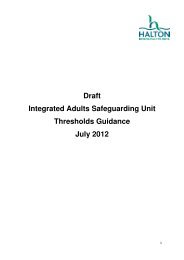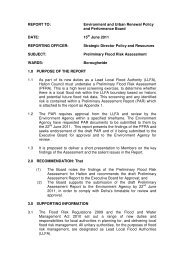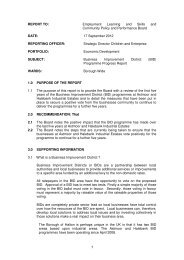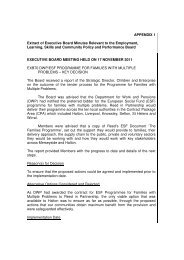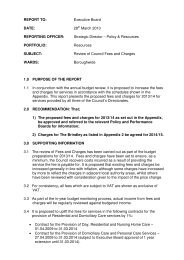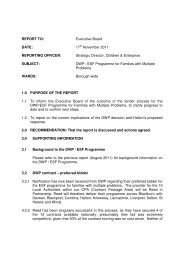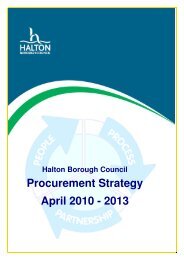Transport Asset Management Plan - Halton Borough Council
Transport Asset Management Plan - Halton Borough Council
Transport Asset Management Plan - Halton Borough Council
You also want an ePaper? Increase the reach of your titles
YUMPU automatically turns print PDFs into web optimized ePapers that Google loves.
<strong>Halton</strong> <strong>Borough</strong> <strong>Council</strong><br />
<strong>Transport</strong> <strong>Asset</strong> <strong>Management</strong> <strong>Plan</strong><br />
4 Levels of Service<br />
4.1 What is Level of Service?<br />
4.1.1 Definition<br />
The Framework for Highway <strong>Asset</strong> <strong>Management</strong> describes Levels of Service as the quality of services<br />
provided by the asset for the benefit of the customers. They are composite indicators that reflect the<br />
social, economic and environmental goals of the community. Levels of Service are therefore the<br />
manner in which we engage with the customer and they therefore reflect the customer’s interests in<br />
terms of what can be measured and evaluated.<br />
They will allow us to:-<br />
• Document and measure the service we provide;<br />
• Evaluate in an objective manner service against cost of provision;<br />
• Clarify whether we are focussing on matters that are important to the customer;<br />
• Establish if our operational systems actively support the achievement of strategic goals;<br />
The framework categorises levels of service as either: -<br />
Condition Assessment<br />
Demand Aspirations<br />
Preservation of the physical integrity of the asset<br />
The service delivered by the asset in terms of its use,<br />
generally expressed in terms of safety, availability,<br />
accessibility, integration etc.<br />
4.1.2 Condition Assessment<br />
The physical condition of the asset has two components: -<br />
• The perceived condition of the asset as “measured” by public and road user<br />
perception.<br />
• The condition of the asset as determined by measurement and analysis of survey<br />
data.<br />
It should be noted that the “perceived condition” of the asset is a relatively new measure and<br />
consequently we have very little prior data on this. Perceived condition will be established by referral<br />
to the results of various public consultations. They can also be created from analysis of public<br />
enquiries and complaints, from routine correspondence and requests for service and from the<br />
outcomes from questionnaires and surveys. Examination of these and other measures will be explored<br />
in more detail in this section of the <strong>Plan</strong>.<br />
4.1.3 Demand Aspirations<br />
Demand aspirations describe the non-condition related performance requirements of the asset and<br />
are used in the determination of service levels for the asset. Examples of performance requirements<br />
are safety, environment, availability, accessibility etc. The measurement of these results against<br />
national and local performance indicators is contained in the LTP.<br />
FinalversionLprovisional0.doc 33







